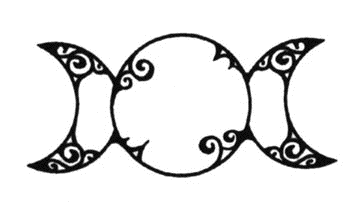The phases of the moon have been
celebrated by cultures all over the world since ancient
times. The moon was mysterious and magical: it changed
monthly from full to half to crescent, disappeared, and
then came back again.
People quickly realized the
relationship between the twenty-eight day moon cycle and
women's menstruation. Thus, the moon was associated with
the feminine, and moon goddesses have existed for eons.
A common thread through many cultures
is the idea of the Triple Goddess: Maiden, Mother and
Crone. The Maiden is represented by the waxing moon
(moving from new moon to full), the Mother by the full
moon, and the Crone by the waning moon (moving from full
to new). The idea of the Triple Goddess works at many
levels: monthly cycles, seasonal cycles, and life
cycles.
In Roman mythology, Diana was the
Maiden. She was depicted as a young woman hunting by
moonlight. The Maiden aspect is associated with early
spring and represents girls and young women. The
characteristics of the maiden are innocence, purity of
spirit, and independence. Post-pubescent maidens are unto
themselves, no longer bound to father, and not yet tied
to husband or children. They often play the role of
warrioress, fighting either against an enemy or on a
quest or mission.
The Roman mother goddess was Selene.
She is patron of hearth and home, and strongly associated
with fertility and birth, both human and animal. Her
seasons are late spring and summer. She is a grain
goddess, and celebrated at planting and harvest. Her role
is that of wife and mother. She is the nurturer, who
gives of herself so that children, animals and crops will
grow and flourish.
Finally, the Crone completes the cycle
of youth, adulthood and old age. The Roman crone was
Hecate. She is associated with old age, wisdom, healing,
and death. Her seasons are fall and winter, and she was
honored at Samhain, or Halloween. She has been
stereotyped as the wicked old witch in modern culture.
Her role originally was the post-menopausal wise woman,
who is nearing the end of life. She shares her wisdom and
healing powers with others, and also becomes
introspective as she prepares for death. The death of the
crone is a necessary culmination of the cycle, and is
followed by the rebirth of the maiden aspect.
We can still learn from the ancient
idea of the Triple Goddess. It teaches us to honor all
aspects of life, including old age and death. We can
become more in tune with the cycles, and pay attention
once more to what is happening in nature, and how it is
reflected in our lives.
New Moon
(Penumbraed with
earthshine)
by Judy Lisciandro Long
A black wheel in the
sky
The ghost
of the goddess
Who dances her slow,
Sacred phases around
our sphere;
of the hub
that beats its
bearings
into the whorls
of our herstories
And dances.
|
Editor's Note: Judy Liscandro Long is our
favorite Chautauqua County poet and a freelance
writer.
Check out our Moon Phases on the homepage for
a listing of the full moons for the coming year.
For more detailed information on the dates for
the new moons or quarters, try the Old Farmer's
Almanac, which is our bible for seasonal and
astronomical events. Below is a ditty we found
in the Farmer's Almanac (1994) about
moonrise:
The New Moon always rises at
sunrise
And the First Quarter at noon.
The Full Moon always rises at sunset
And the Last Quarter at
midnight.
|
Home
